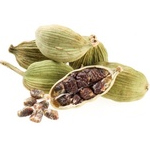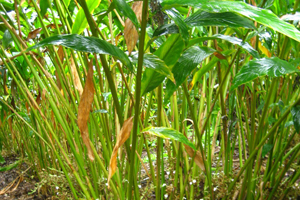You are in : GARDENING » Herbs & Spices » Cardamom
Cardamom
| Latin Name : Elettaria cardamomum Maton |
| Family : Zingiberaceae (Ginger Family) |
| Common names : Small Cardamom, Lesser Cardamom, True Cardamom, Malabar Cardamom,
Green Cardamom |
| |
Native to India, Cardamom is a herbaceous perennial plant belonging to the
ginger family. Its dried fruit referred to as the queen of spices, is one of the most exotic and highly prized
spices in the world. It is found
commonly in southern India mainly in Kerala, Tamilnadu and Karnataka, on the
shady slopes of the western Ghats. Today,
Cardamom is also cultivated in Nepal, Sri Lanka, Guatemala, Mexico, Thailand and
Central America. Cardamom acts as a mouth-freshener, has well established
culinary values, and is used in a wide range of sweets and confectionery. It is
an important ingredient of garam masala, a combination spice for many vegetarian
and non-vegetarian Indian dishes. Tea and coffee made with cardamom are
pleasantly aromatic and refreshing. The oil contained in the seeds and pods are
used in perfumes and as a stimulant.
This bushy herb will grow to a height of 6 to10 feet with erect shoots from a
thick, underground rootstock. The shoots bear
two rows of dark green leaves each about 2 inches long. The leaves are long,
alternate and lance-shaped. The small, yellowish flowers are borne on panicles
and they emerge directly from the underground stem on long floral stalks. The
fruit are ovoid or oblong, greenish-brown capsules containing about
15-20 seeds attached to axial placenta. The seeds have a warm, slightly pungent
and highly aromatic flavour.
Propagation, Planting and Harvesting

Cardamom is propagated vegetatively by division of the rhizomes or by seeds. For vegetative propagation, rhizomes from large clumps of
growing plants are taken out, separated into small clumps and planted in prepared
pits. Seeds may be collected from well ripened fruits from a healthy mature plant at
least five years old. They may be washed and sown immediately or they can be
mixed with ash and dried for a week before sowing. They can be sown in deep rich
soil prepared with well rotted organic matter, on raised beds. The plant
prefers loamy soils rich in organic matter, which are usually acidic in
nature with a pH range of 5.0 to 6.5. It thrives best under moderate shade. The
seeds germinate 5-7 weeks after sowing and are ready to be transplanted when
they reach a height of 25-30 cm and develop a couple of leaves. Plant them 6-18 inches apart
in small pits not too deep. Seedlings should be supported by stakes and mulched.
Water to keep the beds moist, too much watering is not good. Spray occasionally with Bordeaux mixture to prevent fungal attack.
Regular weeding, removal of old and dying leafy shoots,
mulching, regulating the shade, manuring, application of fertilizer and
irrigation are essential for their proper growth. Cardomoms grow abundantly in altitudes ranging from 900 to 1370 m above sea
level, with a warm humid atmosphere and evenly distributed rainfall. Planting is
usually done in June- July. The plants prefers shade.
Cardamoms start bearing capsules three years after planting, which may be the fourth
or fifth year after sowing. Flowering commences in April-May and continues till July-August.
Capsules just short of full ripeness are harvested in October-November in
most of the areas, usually at intervals of 30-40 days. Harvested fruits are dried by exposing them to sun light or by heating or by
flue curing. Capsules which lack uniform green colour are bleached
by using bleaching powder, sulphur dioxide or hydrogen peroxide. After the first
crop, higher and sustained yields are obtained in subsequent years up to the
tenth or fifteenth year, depending on the type cultivated, after which the
plants become exhausted.
Problems and Care
Cardamom plants are affected by a number of diseases caused by virus, fungi
and bacteria. Katte (viral) Disease is one of the major diseases of cardamom.
Diseased plants cannot be cured but the losses can be minimized by using healthy
seedlings, repeating tracing of affected plants and rouging at weekly intervals
for at least 4 consecutive months, avoiding rhizome planting using materials
taken from disease affected gardens. Chenthal is another disease seen in almost all areas of
cardamom cultivation. The intensity of the disease can be reduced by providing
adequate shade in the plantations. Various types of leaf spots are found
to affect the leaves. Application of Fungicides effectively control the disease.
Questions of
Questions & Answers |
|
| 1. |
Posted on :
26.4.2012 By : Geetha , Coimbatore
|
View Answer (0)
|
Post Answer
|
|
| |
Sir, I would like to grow cardamom in my home garden. Is it possible to grow in this place? Where can i get the seeds or sapling? |
|
|
|
|
| 2. |
Posted on :
4.9.2010 By : Radhika , Pune, Pune
|
View Answer (2)
|
Post Answer
|
|
| |
What are Burdock seeds called in India and where can i get them here in India? |
|
|
| A1: |
Arctium lappa, commonly called greater burdock, gobō, edible burdock, lappa, ... Propagation is achieved through sowing the seeds midsummer.
More : https://jkmpic.blogspot.com/2020/08/gobo-seeds-for-sale.html |
| |
Posted By :Sheikh Gulzaar , Kashmir | On 16.9.2020 |
|
| A2: |
In marathi it is called ghagra. Burdock is a plant that is related to the daisy family. It is also closely related to Echinacea, Dandelion, and Feverfew. Burdock is an herb but it is one that has been much neglected when it comes to getting attention. Back in ancient times the Greeks used the roots, the seeds, and the greens and used them for healing purposes. Throughout the Middle Ages Burdock was used for both food and medicine.
Today, Burdock is still used for such things as easing liver problems and digestive disorders. It was also found to be very effective for cleansing the skin for problems such as acne and also to assist in digestive problems. To this day throughout Europe the stalk and the greens are still eaten because they hold such valuable nutrition and vitamin values.
As more and more research is being done on Burdock many new and interesting discoveries are cropping up. A relationship is being examined between Burdock and its anti fungal and anti bacterial properties, and even more important it is showing signs of possibly being able to fight against tumors and could be a cancer fighting agent as well. Research has shown that since many of the cancer causing compounds are in almost all foods which are then eaten and stored in the human fat tissues that Burdock might very well be of help in fighting cancer because of the role that it can play in depleting these mutagens.
Burdock is also very helpful in strengthening the immune system when it has become weakened by environmental factors. When mixed with other herbs such as Dandelion and Ginger it can be a very powerful blood purifier. The most unique fact about Burdock is that it has a very high amount of inulin which is a natural occurring chemical within the body that mimics actions of insulin. Because of this, Burdock has been successful in helping combat hypoglycemia and pre diabetes conditions.
If you look for Burdock in the market you may find it called gobo instead as that is what some refer to it as. It is often combined with other vegetables or added to Tofu. Some boil Burdock while others sautי or deep fry it. Many have said it might not be such a good idea to look at Burdock before you eat it because you might change your mind about taking a bite.
It looks thick, dark, and woody but indeed the opposite is true when it comes to the taste. Burdock is well recognized as a health food because it has low calorie content and a high fiber intake. It is also loaded with potassium, iron, and calcium. People claim that Burdock tastes like nothing else. In other words it has a taste all of its own.
The best description that people can agree on when it comes to the flavor of Burdock is that it is sweet yet earthy, with a tender and crisp texture. It is often added to stews, soups, and stir fries. In the form of food, Burdock is highly nutritional and full of vitamins but in retrospect Burdock is also an effective herb for bringing the body back into balance. |
| |
Posted By :Yashashri Joshi , Thane | On 14.3.2012 |
|
|
|
|
| 3. |
Posted on :
28.3.2010 By : Linda , Michigan
|
View Answer (1)
|
Post Answer
|
|
| |
Can a Clove tree be bonsai or grow as house plants like bay leaf or allspice? |
|
|
| A1: |
Yes, Clove is a nice tree to plant in a house, Also you can maintain as a bonsai. |
| |
Posted By :Rynco Orchids , trivandrum | On 17.4.2010 |
|
|
|
|
| » more... |



